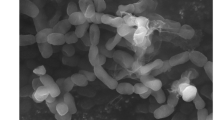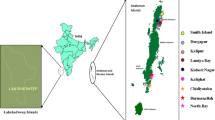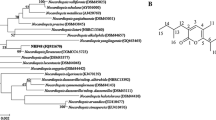Abstract
Twenty-nine actinobacterial strains were isolated from marine sponge Spongia officinalis and screened for antagonistic activity against various bacterial and fungal pathogens. The active antibiotic producer MAPS15 was identified as Streptomyces sp. using 16S rRNA phylogenetic analysis. The critical control factors were selected from Plackett–Burman (PB) factorial design and the bioprocess medium was optimized by central composite design (CCD) for the production of bioactive metabolite from Streptomyces sp. MAPS15. The maximum biomass and active compound production obtained with optimized medium was 6.13 g/L and 62.41 mg/L, respectively. The economical carbon source, paddy straw was applied for the enhanced production of bioactive compound. The purified active fraction was characterized and predicted as pyrrolidone derivative which showed broad spectrum of bioactivity towards indicator organisms. The predicted antimicrobial spectra suggested that the Streptomyces sp. MAPS15 can produce a suite of novel antimicrobial drugs.





Similar content being viewed by others
References
Sipkema D, Franssen MC, Osinga R, Tramper J, Wijffels RH (2005) Marine sponges as pharmacy. Mar Biotechnol 7:142–162
Kennedy J, Marchesi JR, Dobson AD (2007) Metagenomic approaches to exploit the biotechnological potential of the microbial consortia of marine sponges. App Microbiol Biotechnol 75:11–20
Proksch P, Edrada RA, Ebel R (2002) Drugs from the sea-current status and microbiological implications. App Microbiol Biotechnol 59:125–134
Berdy J (1989) In: Bushell ME, Grafe U (ed) Bioactive metabolites from microorganisms. Elsevier Science Publications, Amsterdam, pp 3–25
Kennedy J, Baker P, Piper C, Cotter PD, Walsh M, Mooij MJ, Bourke MB, Rea MC et al (2009) Isolation and analysis of bacteria with antimicrobial activities from the marine sponge Haliclona simulans collected from Irish waters. Mar Biotechnol 11:384–396
Zhang H, Lee YK, Zhang W et al (2006) Culturable actinobacteria from the marine sponge Hymeniacidon perleve: isolation and phylogenetic diversity by 16S rRNA gene-RFLP analysis. Antonie Van Leeuwenhoek 90:159–169
Ramadhas V, Santhanam R, Venkataramani VK, Sundararaj V (1999) Gulf of Mannar: A Profile. Fisheries College and Research Institute Publication, Tuticorin
Selvin J, Shanmugapriya S, Gandhimathi R, Kiran GS, Ravji TR, Natarajaseenivasan K, Hema TA (2009) Optimization and production of novel antimicrobial agents from sponge associated marine actinomycetes Nocardiopsis dassonvelli MAD08. App Microiol Biotechnol 83:435–445
Selvin J, Soniya J, Asha KRT, Manjusha WA, Sangeetha VS, Jayaseema DM, Antony MC, Denslin Vinitha AJ (2004) Antibacterial potential of antagonistic Streptomyces sp. isolated from marine sponge Dendrilla nigra. FEMS Microbiol Ecol 50:117–122
Gandhimathi R, Arunkumar M, Selvin J, Thangavelu T, Sivaramakrishnan S, Seghal Kiran G, Shanmughapriya S, Natarajaseenivasan K (2008) Antimicrobial potential of sponge associated marine actinomycetes. J Mycol Med 18:16–22
Lechevalier HA (1989) In: Williams ST et al (ed) Bergey’s manual systematic bacteriology, vol 4. Williams & Wilkins, Baltimore, pp 2344–2347
Lu Z, Wang L, Zhang Y, Shi Y, Liu Z, Quintana ET, Goodfellow M (2003) Actinomadura catellatispora sp. nov. and Actinomadura glaucifava sp. nov., from a sewage ditch and soil in southern China. Int J Syst Evol Microbiol 53:137–142
Pridham TG, Gottlieb D (1948) The utilization of carbon compounds by some Actinomycetales as an aid for species determination. J Bacteriol 56:107–114
Montgomery DC (2001) Design and analysis of experiments. Wiley, New York, pp 455–492
Grammer A (1976) In: Collins CH, Lyne PM (eds) Microbiological methods. Butterworths, London
Acar JF (1980) In: Lorian V (ed) Antibiotics in laboratory medicine. Williams & Wilkins, Baltimore
Kiran GS, Anto Thomas T, Selvin Joseph, Sabarathnam B, Lipton AP (2010) Optimization and characterization of a new lipopeptide biosurfactant produced by marine Brevibacterium aureum MSA13 in solid state culture. Bioresour Technol 101:2389–2396
Csaky TZ (1948) On the estimation of bound hydroxylamine in biological materials. Acta Chem Scand 2:450–454
Arnow LE (1937) Colorimetric determination of the components of 3,4-dihydroxyphenylalanine-tyrosine mixtures. J Biol Chem 118:531–537
Neilands JB (1984) Methodology of siderophores. Siderophores from microorganisms and plants. Struct Bond 58:1–24
Chen X, Li Y, Du GC, Chen J (2005) Application of response surface methodology in medium optimization for spore production of Coniothyrium minitans in solidstate fermentation. World J Microbiol Biotechnol 21:593–599
Haider MA, Pakshirajan K (2007) Screening and optimization of media constituents for enhancing lipolytic activity by a soil microorganism using statistically designed experiments. App Bichem Biotechnol 141:377–390
Gross E, Morell JL (1971) The structure of nisin. J Am Chem Soc 93:4634–4635
Motta AS, Brandelli A (2008) Evaluation of environmental conditions for production of bacteriocin-like substance by Bacillus sp. Strain P34. World J Microbiol Biotechnol 24:641–646
Basilio A, Gonzalez I, Vicente MF, Gorrochategui J, Cabello A, Gonzalez A et al (2003) Patterns of antimicrobial activities from soil actinomycetes isolated under different conditions of pH and salinity. J App Microbiol 95:814–823
Iwai Y, Omura S (1982) Culture conditions for screening of new 1antibiotics. J Antibiotic 35:12–14
Srinivasan MC, Laxman RS, Deshpande MV (1991) Physiology and nutritional aspects of actinomycetes: an overview. World J Microbiol Biotechnol 7:171–184
Saha M, Ghosh JD, Ghosh D, Garai D, Jaisankar P, Sarkar KK et al (2005) Studies on the production and purification of an antimicrobial compound and taxonomy of the producer isolated from the marine environment of the Sundarbans. App Microbiol Biotechnol 66:497–505
Vijayakumar R, Panneerselvam K, Muthukumar C, Thajuddin N, Panneerselvam A, Saravanamuthu R (2011) Optimization of antimicrobial production by a marine actinomycete Streptomyces afghaniensis VPTS3-1 Isolated from Palk Strait, East Coast of India. Indian J Microbiol. doi:10.1007/s12088-011-0138-x
Lima-Filho JVM, Carvalho AFFU, Freitas SM (2002) Antibacterial activity of extracts of six macroalgae from the Northeastern Brazillian coast. Brazilian J Microbiol 33:311–333
Narayana JP, Prabhakar P, Vijayalakshmi M, Venkateswarlu Y, Krishna SJ (2008) Study of bioactive compounds from Streptomyces sp. ANU 6277. Pol J Microbiol 57:35–39
Roy RN, Laskar S, Sen SK (2006) Dibutyl phthalate the bioactive compound produced by S. albidoflavus 321.2. Microbiol Res 161:121–126
Deepak V, Kalishwaralal K, Ramkumarpandian S, Venkatesh Babu S, Senthilkumar SR, Sangiliyandi G (2008) Optimization of media composition for nattokinase production by Bacillus subtilis using response surface methodology. Bioresour Technolo 99:8170–8174
Wang WL, Chi ZM, Chi Z, Li J, Wang XH (2009) Siderophore production by the marine-derived Aureobasidium pullulans and its antimicrobial activity. Bioresour Technol 100:2639–2641
Braun V, Pramanik A, Gwinner T, Koberle M, Bohn E (2009) Sideromycins: tools and antibiotics. Biometals 22:3–13
Acknowledgments
Authors thank Council of Scientific and Industrial Research (CSIR), New Delhi, India for research grant.
Author information
Authors and Affiliations
Corresponding author
Rights and permissions
About this article
Cite this article
Sathiyanarayanan, G., Gandhimathi, R., Sabarathnam, B. et al. Optimization and production of pyrrolidone antimicrobial agent from marine sponge-associated Streptomyces sp. MAPS15. Bioprocess Biosyst Eng 37, 561–573 (2014). https://doi.org/10.1007/s00449-013-1023-2
Received:
Accepted:
Published:
Issue Date:
DOI: https://doi.org/10.1007/s00449-013-1023-2




